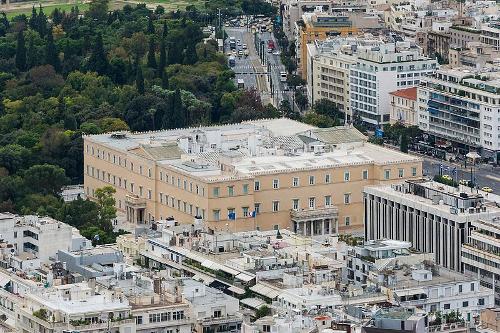MYKONOS
Society

Society
Popular destinations GREECE
| Aegina | Alonissos | Andros |
| Chios | Corfu | Crete |
| Hydra | Kalymnos | Karpathos |
| Kefalonia | Kos | Lefkas |
| Lesbos | Mykonos | Naxos |
| Paros | Patmos | Peloponnese |
| Poros | Rhodes | Samos |
| Santorini | Skiathos | Skopelos |
| Spetses | Thasos | Zakynthos |
Society
State structure
 Greece VouliPhoto: Jebulon in the public domain
Greece VouliPhoto: Jebulon in the public domain
The constitution dates from 1975, after which important amendments were made in 1986. Legislative power rests with the unicameral parliament (the "Vouli"), whose 300 members are elected once every four years under an "enhanced right of proportional election". The system favors the strongest party in order to achieve a majority sufficient for government, which, however, encourages a two-party system.
The head of state is the president, who is elected by parliament (a two-thirds majority is required) for a term of five years and is eligible for re-election once. The president appoints and dismisses the prime minister. He may also dissolve parliament and in a state of emergency he can issue laws by decree. His function is largely ceremonial, as head of state he has no executive power. This power rests with the Council of Ministers, which is accountable to parliament for this. There is universal suffrage for all Greeks from the age of 18.
After the military dictatorship, a popular vote on the return of the monarchy to the disadvantage of ex-king Constantine was unfavorable. For the current political situation see chapter history.
Greece received a new administrative division on 1 January 2011 as part of an overall administrative reform, which was named after Kallikratis, a Greek architect from the mid-5th century BC.
Administrative division
 Greece administrative divisionPhoto: TUBS CC 3.0 Unported no changes made
Greece administrative divisionPhoto: TUBS CC 3.0 Unported no changes made
The 13 administrative regions of Greece are Attica (1), Central Greece (2), Central Macedonia (3), Crete (4), Eastern Macedonia and Thrace (5), Epirus (6), Ionian Islands (7), Northern Aegean (8), Peloponnese (9), South Aegean (10), Thessaly (11), Western Greece (12) and Western Macedonia (13).
With the administrative reorganisation of 2011, Mykonos became a regional unit of the administrative region of South Aegean Islands, which further comprises the islands of Andros, Kalymnos, Karpathos, Kea-Kythnos, Kos, Milos, Naxos, Paros, Rhodes, Syros, Thira and Tinos.
Geographically, Mykonos belongs to the Northern Cyclades, an island group just east of the Peloponnese, which also includes Andros, Tinos and Syros. Besides the Northern Cyclades, there are also the Western Cyclades (including Kythnos, Melos and Serifos), the Central and Eastern Cyclades (including Naxos, Paros and Antiparos), the Small Cyclades (including Iraklia, Keros and Donousa) and the Southern Cyclades (including Folegandros, Ios and Santorini).
As of 2011, the South Aegean Islands region consists of thirteen regional units (periferiaki enotita): Mykonos, Andros, Kalymnos, Karpathos, Kea-Kythnos, Kos, Milos, Naxos, Paros, Rhodes, Syros, Thira and Tinos. Before 2011, the current administrative region of the South Aegean Islands consisted of the departments (nomi) of the Cyclades and the Dodecanese. Mykonos, like the other regional units, no longer has its own administration. For the current political situation in Greece, see the history section.
Sources
Wikipedia
CIA - World Factbook
BBC - Country Profiles
Last updated December 2025Copyright: Team The World of Info